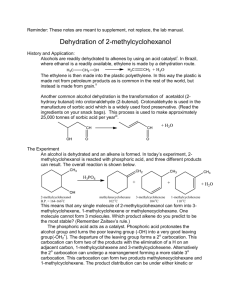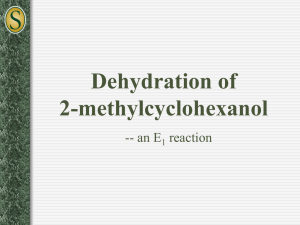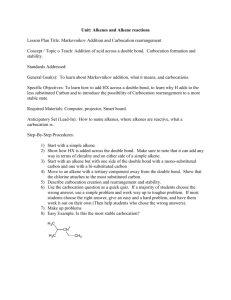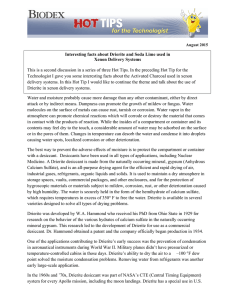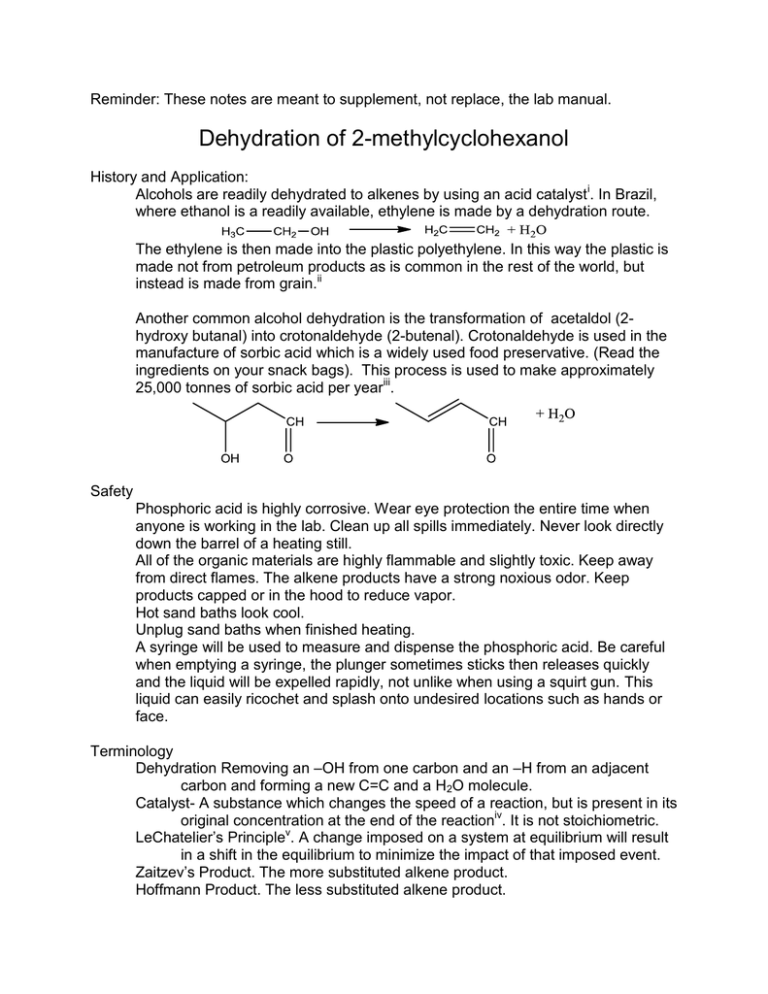
Reminder: These notes are meant to supplement, not replace, the lab manual.
Dehydration of 2-methylcyclohexanol
History and Application:
Alcohols are readily dehydrated to alkenes by using an acid catalyst i. In Brazil,
where ethanol is a readily available, ethylene is made by a dehydration route.
The ethylene is then made into the plastic polyethylene. In this way the plastic is
made not from petroleum products as is common in the rest of the world, but
instead is made from grain.ii
Another common alcohol dehydration is the transformation of acetaldol (2hydroxy butanal) into crotonaldehyde (2-butenal). Crotonaldehyde is used in the
manufacture of sorbic acid which is a widely used food preservative. (Read the
ingredients on your snack bags). This process is used to make approximately
25,000 tonnes of sorbic acid per yeariii.
Safety
Phosphoric acid is highly corrosive. Wear eye protection the entire time when
anyone is working in the lab. Clean up all spills immediately. Never look directly
down the barrel of a heating still.
All of the organic materials are highly flammable and slightly toxic. Keep away
from direct flames. The alkene products have a strong noxious odor. Keep
products capped or in the hood to reduce vapor.
Hot sand baths look cool.
Unplug sand baths when finished heating.
A syringe will be used to measure and dispense the phosphoric acid. Be careful
when emptying a syringe, the plunger sometimes sticks then releases quickly
and the liquid will be expelled rapidly, not unlike when using a squirt gun. This
liquid can easily ricochet and splash onto undesired locations such as hands or
face.
Terminology
Dehydration Removing an –OH from one carbon and an –H from an adjacent
carbon and forming a new C=C and a H2O molecule.
Catalyst- A substance which changes the speed of a reaction, but is present in its
original concentration at the end of the reactioniv. It is not stoichiometric.
LeChatelier’s Principlev. A change imposed on a system at equilibrium will result
in a shift in the equilibrium to minimize the impact of that imposed event.
Zaitzev’s Product. The more substituted alkene product.
Hoffmann Product. The less substituted alkene product.
Thermodynamic Control. When the most stable product forms in the highest
percent.
Kinetic Control. When the product with the lowest activation energy, and hence
the fastest rate forms in the highest percent.
The Experiment
1. An alcohol is dehydrated and an alkene is formed. In today’s experiment, 2methylcyclohexanol is reacted in the presence of phosphoric acid, and three
different products can result. The overall reaction is shown below.
2-methylcyclohexanol
B.P.vi = 164-166oC
(cis 165.6, trans 166.8 oC)
methylenecyclohexane
102 oC
3-methylcyclohexene
104 oC
1-methylcyclohexene
110 oC
This means that any single molecule of 2-methylcyclohexanol can form any of
the following three molecules; 3-methylcyclohexene, 1-methylcyclohexene or
methylenecyclohexane. One molecule cannot form 3 molecules. Which product
alkene do you predict to be the most stable? (Remember Zaitsev’s rule.)
One mole of starting material can form a total of one mole of any one or all three
products. The sum of the mole fractions of the products cannot exceed the
moles of starting material.
2. The phosphoric acid acts as a catalyst. This means that the reaction will precede very
slowly or not at all without its presence, but that the amount of product produced
is not directly tied to the amount of catalyst present. It is consumed and
regenerated along the course of the reaction. It is not stoichiometric.
3. The E1 mechanism describes how all three products are able to form. Phosphoric
acid protonates the alcohol group and turns the poor leaving group (-OH) into a
very good leaving group(-OH2+). The departure of the leaving group forms a 2o
carbocation. This is a slow step and the rate determining step (RDS). The
carbocation can form two of the products with the elimination of a H on an
adjacent carbon, 1-methylcyclohexene and 3-methylcyclohexene. Alternatively
the 2o carbocation can undergo a rearrangement forming a more stable 3 o
carbocation. This carbocation can form two products methylenecyclohexane and
1-methylcyclohexene. The product distribution can be under either kinetic or
thermodynamic control. Typically the conditions in this lab favor thermodynamic
control. The full mechanism follows.
The dehydration of 2-methylcylcohexanol begins with the reversible
protonation of the -0H by the acid, transforming it from a poor leaving group to a
good leaving group. This group leaves as a water molecule, forming a 2o
carbocation in the rate determining step.
4. Alkenes with the highest degree of alkyl substitution are the lowest energy and most
stable. When a reaction is under thermodynamic control the most energetically
favored product is formed preferentially. vii The stability of alkenes is directly tied
to the degree of substitution.
Knowing this, which of the three products is predicted to be present in the largest
amount if this reaction is under thermodynamic control?
If this reaction is instead under kinetic control, which product would be predicted
to be the major product? (Think about the ‘easiest’ hydrogen to remove from the
initial carbocation.)
5. If a reaction is under thermodynamic control it means the product with the lowest
energy (most stable) forms in the largest yield. If a reaction is under kinetic
control it means the product with the lowest activation energy (easiest to form) is
present in the largest yield. The kinetic and thermodynamic product may be the
same or different depending on the exact reaction energetics. Look at the two
reaction coordinates below. In the reaction coordinate on the left, the product “C”
is the thermodynamic product because it is lower energy than “B”. The product
“B” is the kinetic product because it has a lower activation energy and hence
needs less energy to form than C. In the reaction coordinate on the right, the
kinetic product is E and the thermodynamic product is also E. The dehydration
reaction perfomed in this lab is most similar to the reaction coordinate on the left.
viii
In the alkene formation from the 2o carbocation, the 1-methylcyclohexene is the
thermodynamic product because it is the most stable. The 3-methylcyclohexene
is the kinetic product because it is easier to remove either of the two hydrogens
on the methylene carbon (-CH2-) than the hydrogen on the tertiary carbon (C-H).
Procedure
The reaction will be carried out in a Hickman still. These are custom
manufactured and relatively expensive pieces of glassware. The Drierite,
phosphoric acid, and 2-methylcyclohexanol are contained in the bottom portion of
the still.
Only the lower 1/3 of the still bottom should be buried in the sand. Some Drierite
should be above the level of the sand. The Drierite will absorb the water from the
85% phosphoric acid and absorb the water that is liberated during the
dehydration. Remember what you learned in general chemistry about
LeChatlier’s principle. In this reaction 2-methylcyclohexanol is undergoing a
reaction to form an alkene and a molecule of water. What is expected to the
reaction equilibrium if the water is removed from the reaction by absorption into
the Drierite? The Drierite also acts as a boiling stone and a fractionation column.
The temperature of the sand should not be allowed to rise above the boiling point
of the 2-methylcyclohexanol. As the products form, they will vaporize (boiling
points 102-110oC), and rise in the still. They will condense on the glass in the
upper portion of the still and run down the glass, collecting in the ring. Why
doesn’t the starting alcohol also vaporize, condense and collect in the ring?
As the reaction is proceeding, the products are being removed by distillation.
How is this expected to impact the equilibrium? (Again think of LeChatlier’s
principle.)
Analysis
The starting alcohol and product will be analyzed using IR. The IR of 2methylcyclohexanol will have a distinct OH stretching absorbance near 3400cm-1.
This peak is absent from the IR spectrum of pure alkene products. Water present
in the product will show a typical absorbance in the 3400cm -1 region and may be
difficult to distinguish from the alcohol stretch. The IR spectrum of the desired
products contains a sp2 =C-H stretch around 3050cm-1. This peak appears as a
shoulder on the normal sp3 C-H absorbance. It is not always clearly discernible.
A C=C stretch may also be observed around 1620cm-1. An IR of pure 2methylcyclohexanol is on the left, and that for a methylcyclohexene is on the
right.ix
Revised: September 18, 2015, S.L. Weaver
References
i
Weissermen, K, Arpe, H.-J., Industrial Organic Chemistry, 3rd Completely Revised Edition, VCH, New York ,
1997 p185
Heaton, A., An Introduction to Industrial Chemistry, 3rd, Blackie Academic and Professional, London, 1996
Chenier, P.J., Survey of Industrial Chemistry, 3rd, Kluwer Academic, New York, 2002
ii
http://www.icis.com/Articles/2009/07/15/9232844/Brazilian-ethanol-attracts-bioplastics-investors.html (January
28, 2010)
iii
http://www.scidesign.com/ September 10, 2009
http://pcinylon.com/pci/details.php?catp=50000000&p_id=4&ojid=8e922196f389c06ef0b2d0810c555145
September 17, 2009
iv
Hackh’s Chemical Dictionary, McGraw Hill, 1969, p138
v
Hill, Petrucci, McCreary, Perry, General Chemistry, 4th Edition, Pearson-Prentice Hall, New Jersey 1996 p589
vi vi
CRC Handbook of Chemistry and Physics, 65th ed, CRC Press, Bocca Raton,1985 pp C-249, C-250, C-253
vii
D. Klein, Organic Chemistry, Wiley, New York, 2012,p344
viii
Ibid, p 250
ix
SDBSWeb : http://sdbs.riodb.aist.go.jp (National Institute of Advanced Industrial Science and
Technology, September28,2013

